Continuing on from my last post, today I’m going to teach you how to make the second part of the edible rose… The rose bud! Since roses are one of the most popular flowers to make out of gum paste, I’ve decided that making a sugar rose should be something you all have the opportunity to learn. So, here I am, hoping to make this process look achievable and fun for you.
Stay tuned for most posts in the future, teaching you how to make medium roses next (half bloom roses), and then large roses (full bloom rose). The final tutorial in my 5-part series will be tinting the roses whatever color you like with petal dusts. I will also be sharing a bonus post, teaching you how to make rose leaves with rose leaf cutters and silicone leaf veiner.
The simpler way to make roses
My rose tutorials have longs lists of tools and instructions, but don’t be intimidated! They aren’t that difficult, once you get the hang of them, and the results are simply stunning. To make the process a little easier for you, I’m teaching you how to make gumpaste roses on toothpicks instead of floral wire with floral tape to make flower stems. This tutorial will focus on making the second part of the rose (after the rose base): a small rose bud.
A example of a cake made with toothpick roses
Here’s some inspiration for you. Look at what you can achieve by learning to make a gum paste rose… The beautiful roses in this photo are made with the same method I’m teaching in this 5-part tutorial:
Yes, I made this wedding cake; and you can too! Roses make a beautiful accent to cakes for all occasions – use them on pretty birthday cakes, anniversary cakes, baby or bridal shower cakes… The sky’s the limit! I also love mixing sugar roses with other sugar flowers for beautiful edible bouquets, but we will leave those tutorials for another day.
How to make a gumpaste rose bud
Are you ready to learn to make some rose buds?? I will outline the 8-10 step process of making roses below, with step-by-step pictures and descriptions of each step.
You will need:
- Pre-made rose bases
- Vegetable shortening
- Plastic Wrap
- Glass of water
- Cornstarch (in a tea ball or cheesecloth bundle, for easy application)
- Gum Paste
- Rolling Pin
- Foam Mat
- Ball/Frill Tools
- Paint Brushes
- Cell stick (optional) – Some gum paste tool kits will include one of these
- Silicone veiner* (optional)
- Rose Cutter Set
- Styrofoam block
*The veiner in this tutorial is hard to find these days, but the silicone ones are much better!
IMPORTANT: Any leftover gum paste will dry out if it’s not kept well-sealed. I recommend wrapping it in plastic, putting it into a ziplock bag, and putting it into a sealed container to keep maximum freshness.
Tip: This tutorial is for making a small roses, as pictured in the cake in the photo above. If you want to make larger roses, you can just use a set of 3 large rose petal cutters and follow the same instructions.

Gum Paste Rose Buds (Edible Rose Buds)
This is part 2/5 on making gum paste roses @naomicakes.com!
Ingredients
- pre-made rose bases enough for the number of roses you want to make (see my previous tutorial for this step)
- 1 golf ball sized piece gum paste (see recipe notes)
- 1-2 tsp vegetable shortening
- plastic wrap
- 1 glass water
- 1 small fondant/gum paste rolling pin
- 3 rose cutters (set)
- 1 foam mat
- corn starch (in a tea ball or cheesecloth bundle, for easy application)
- 1 ball tool/frill tool
- 1 new/clean* paint brush *must be new or only used for this process to be food safe
- 1 cell stick optional
- 1 veining tool optional
- 1 piece styrofoam
Instructions
-
Lightly grease a clean work surface with some vegetable shortening, put a little on your hands, and knead the gum paste until smooth and pliable.
-
Roll the gum paste out until it is quite thin; about 1/8" or a little thinner.
-
Using the smallest rose petal cutter from your set, cut out 4 petal shapes per rose base (example, for 4 roses you would need 16 petals). Remove the excess gum paste from around the cut-outs, shape into a ball, and wrap in plastic. Set aside. Cover the cut rose petal shapes on the table with plastic until ready to use.
-
Lightly dust your foam mat with cornstarch to prevent the petals from sticking (I like putting it into a little homemade cheesecloth bag to make this most simple). Remove 1-4 petals from under the plastic, and gently thin/frill the edges of each petal with the frill or ball tool (also dusted with cornstarch).
-
From the centre outward, roll the veining tool (or press the petals in a silicone veining tool) across the petals to make the impression of vertical veins on each one. You can also use a silicone petal veiner for this step.
-
Dampen the base of one petal with water on the plain side, and wrap it (vein side out) around one rose base, making sure it stands above the top of the base about 1/4", and the petal overlaps itself slightly (as shown in the photos of this tutorial).
-
Moisten the end of another petal on the plain side again, and wrap it around the first petal (vein side out), with the centre of the overlap on the first petal in the middle of the second petal. (See photos in this tutorial.)
-
Repeat with the remaining two petals, tucking each underneath the edge of the previous petal to make a spiral "fan." Use a cell stick to curve the tips of the petals as desired.
-
Stick the toothpick of the finished rose bud into styrofoam; repeat these directions with the other rose bases. Allow the buds to dry at least 12-24 hours before colouring or using them to decorate.
If you are moving on to the next step, you can either let the buds dry or continue on right away.
-
The thoroughly dry roses will keep in a cool, dry place for several months in a closed container. Humidity will cause the roses to "wilt" and you may not be able to keep them.
Recipe Notes
IMPORTANT: Any leftover gum paste will dry out if it’s not kept well-sealed. I recommend wrapping it in plastic, putting it into a ziplock bag, and putting it into a sealed container to keep maximum freshness.
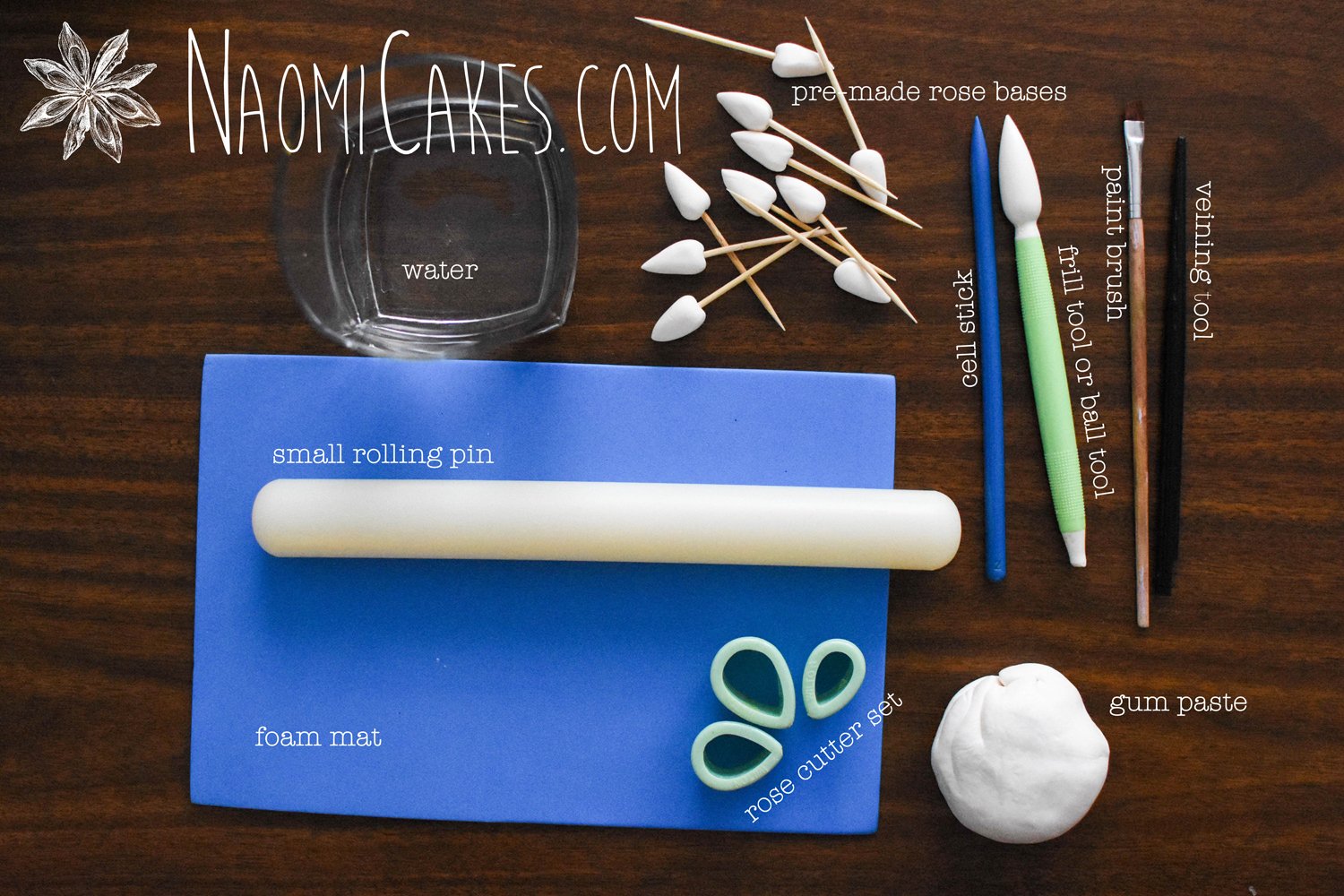
1, 2 & 3 – How to begin
1 – Lightly grease a clean work surface with some vegetable shortening, put a little on your hands, and knead the gum paste until smooth and pliable.
2 – Roll the gum paste out until it is quite thin; about 1/8″ or a little thinner.
3 – Using the smallest rose petal cutter from your set, cut out 4 petal shapes per rose base (example, for 4 roses you would need 16 rose petals). Remove the excess gum paste from around the cut-outs, shape into a ball, and wrap in plastic. Set aside. Cover the cut rose petal shapes on the table with plastic until ready to use.
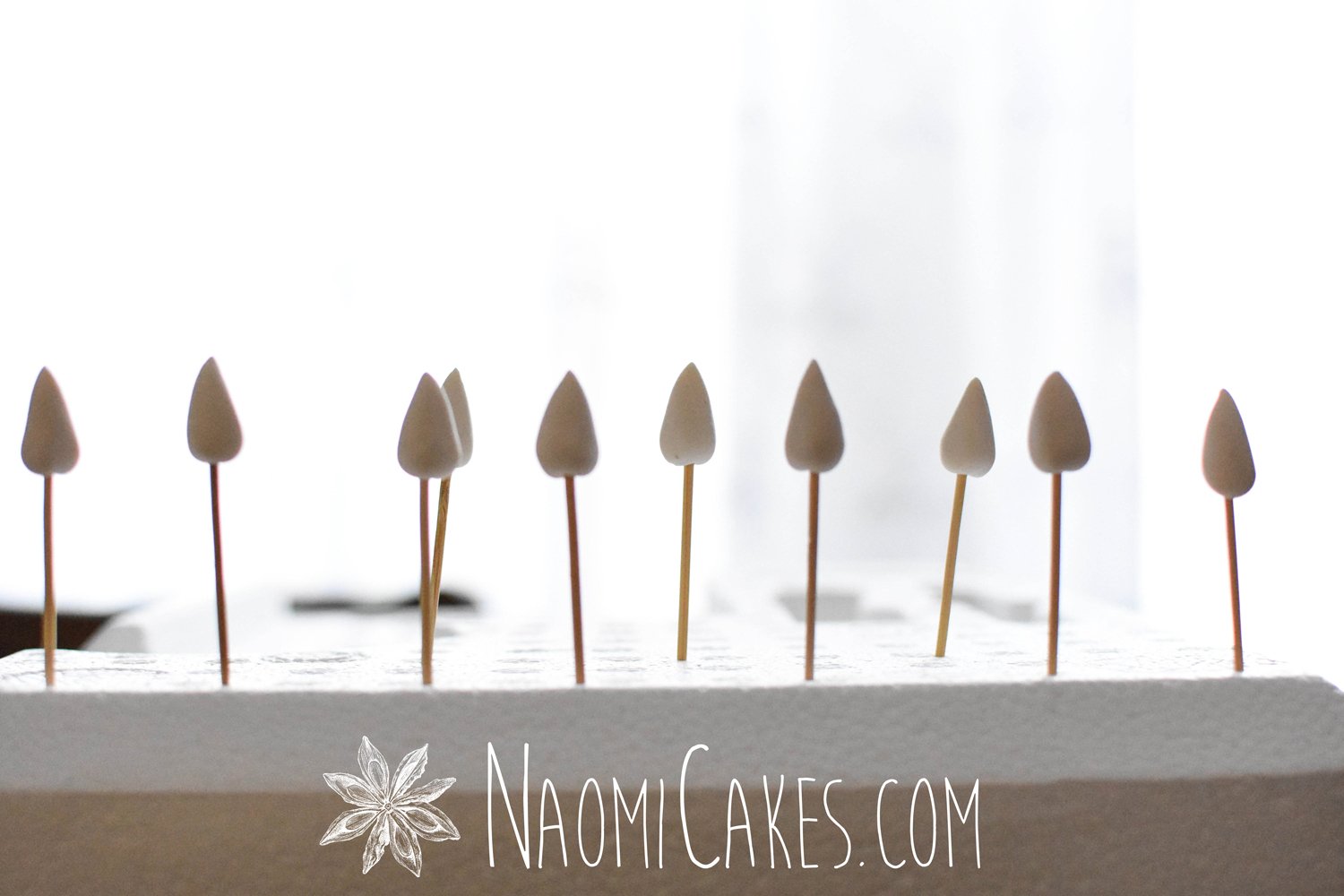
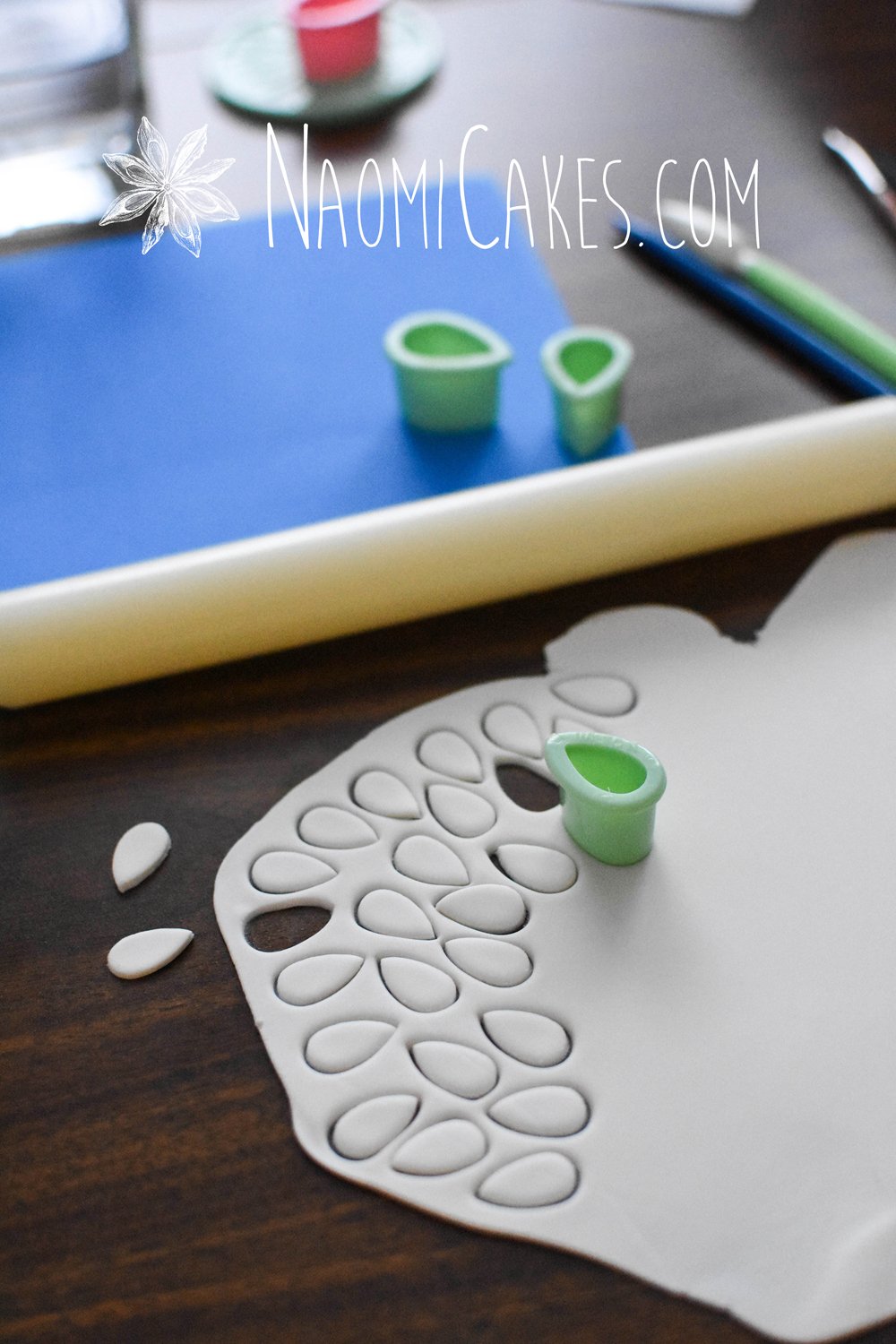
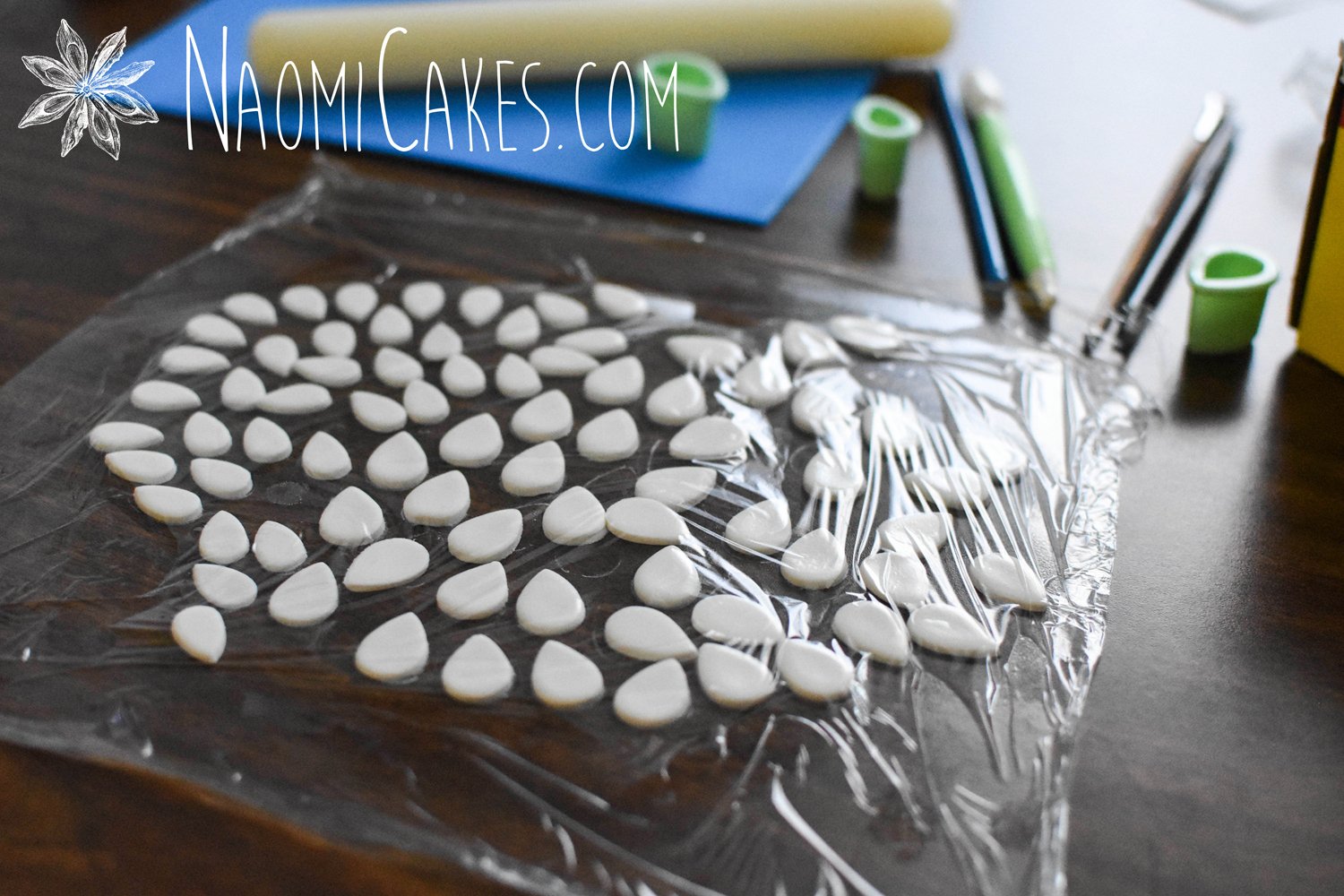
4 – Frilling the petals
Lightly dust your foam mat with cornstarch to prevent the petals from sticking (I like putting it into a little homemade cheesecloth bag to make this most simple). Remove 1-4 petals from under the plastic, and gently thin/frill the edges of each petal with the frill or ball tool (also dusted with cornstarch).
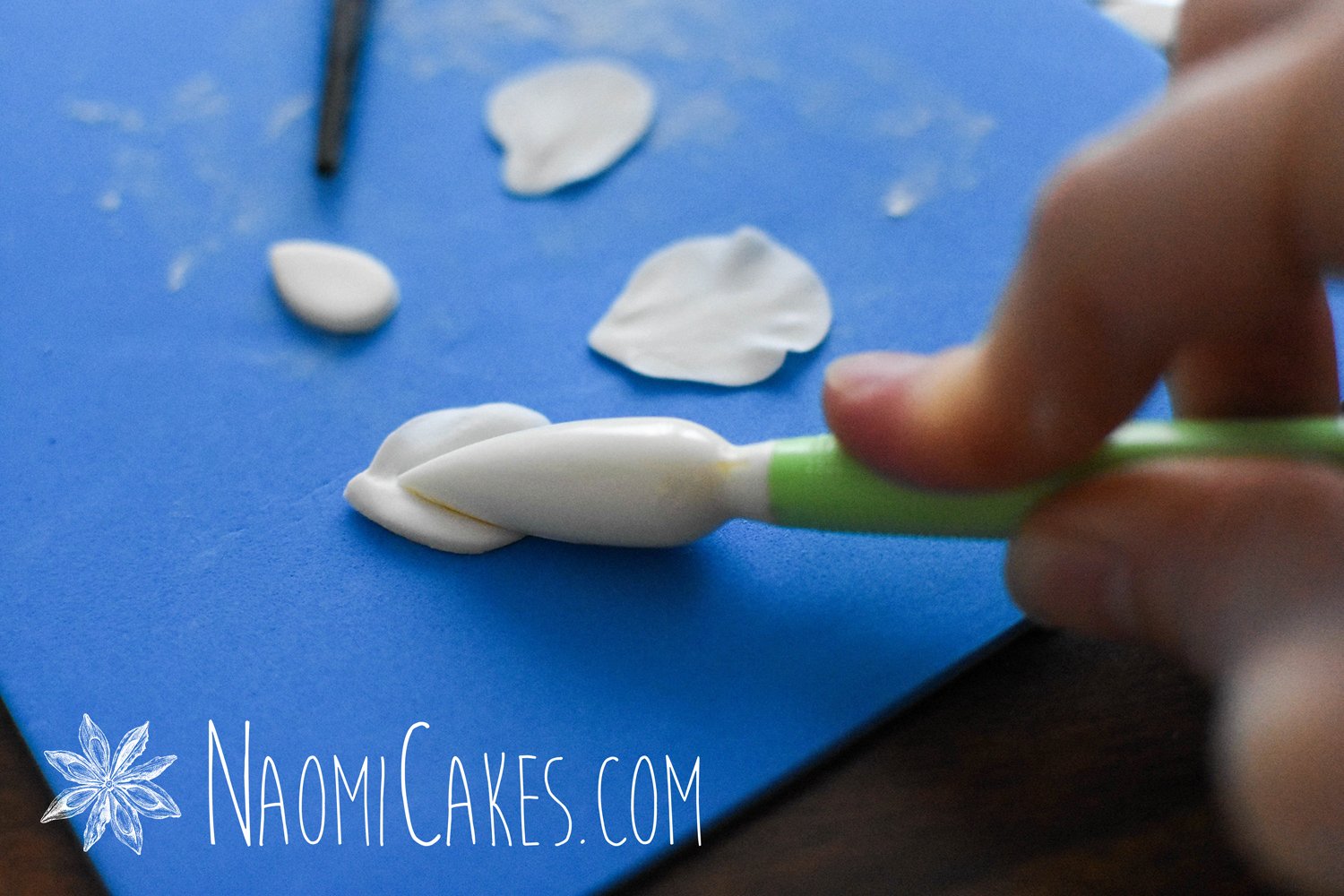
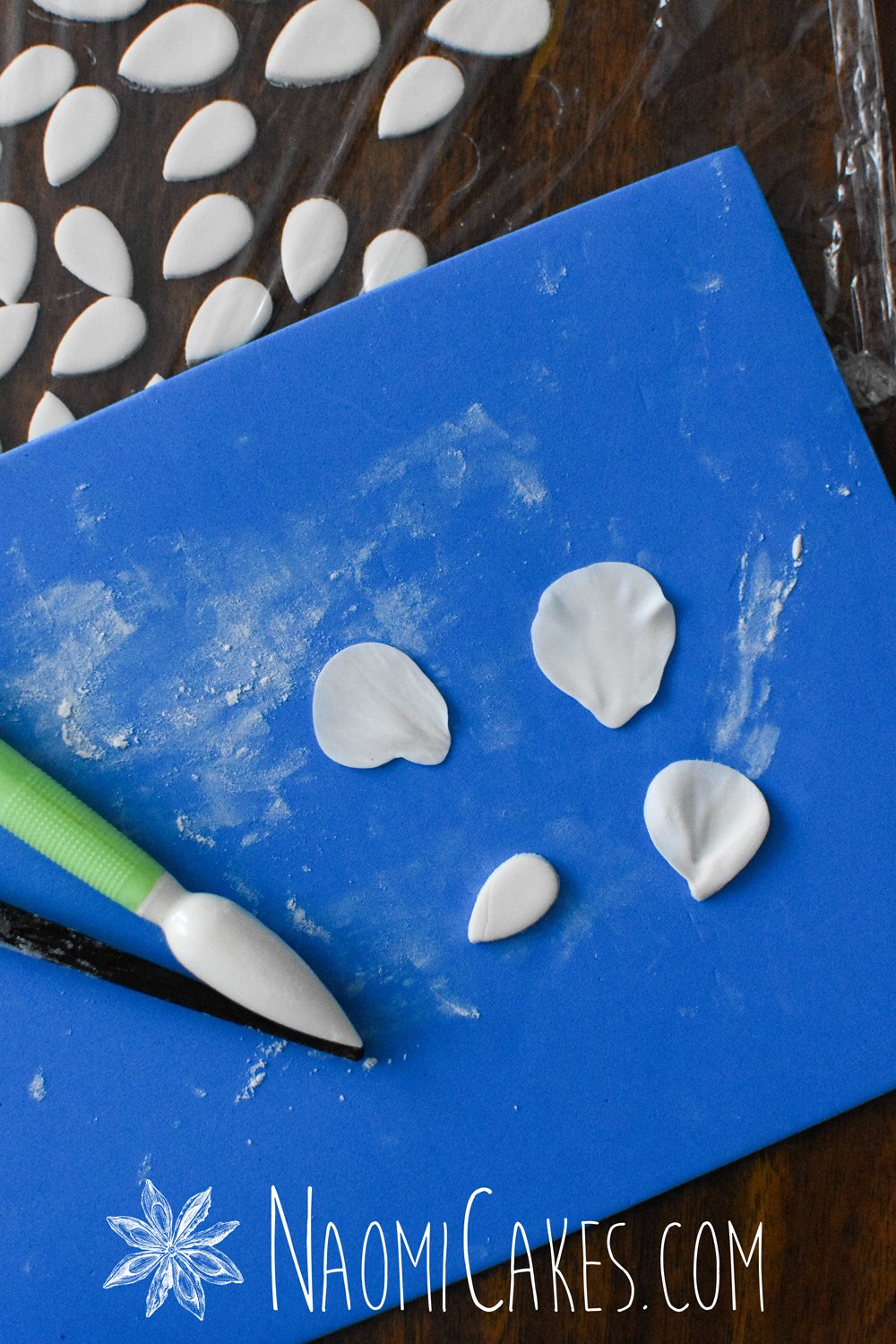
5 – Veining the petals
From the centre outward, roll the veining tool (or press the petals in a silicone veining tool) across the petals to make the impression of vertical veins on each one.
You can also use a silicone petal veiner for this, which is actually much easier.
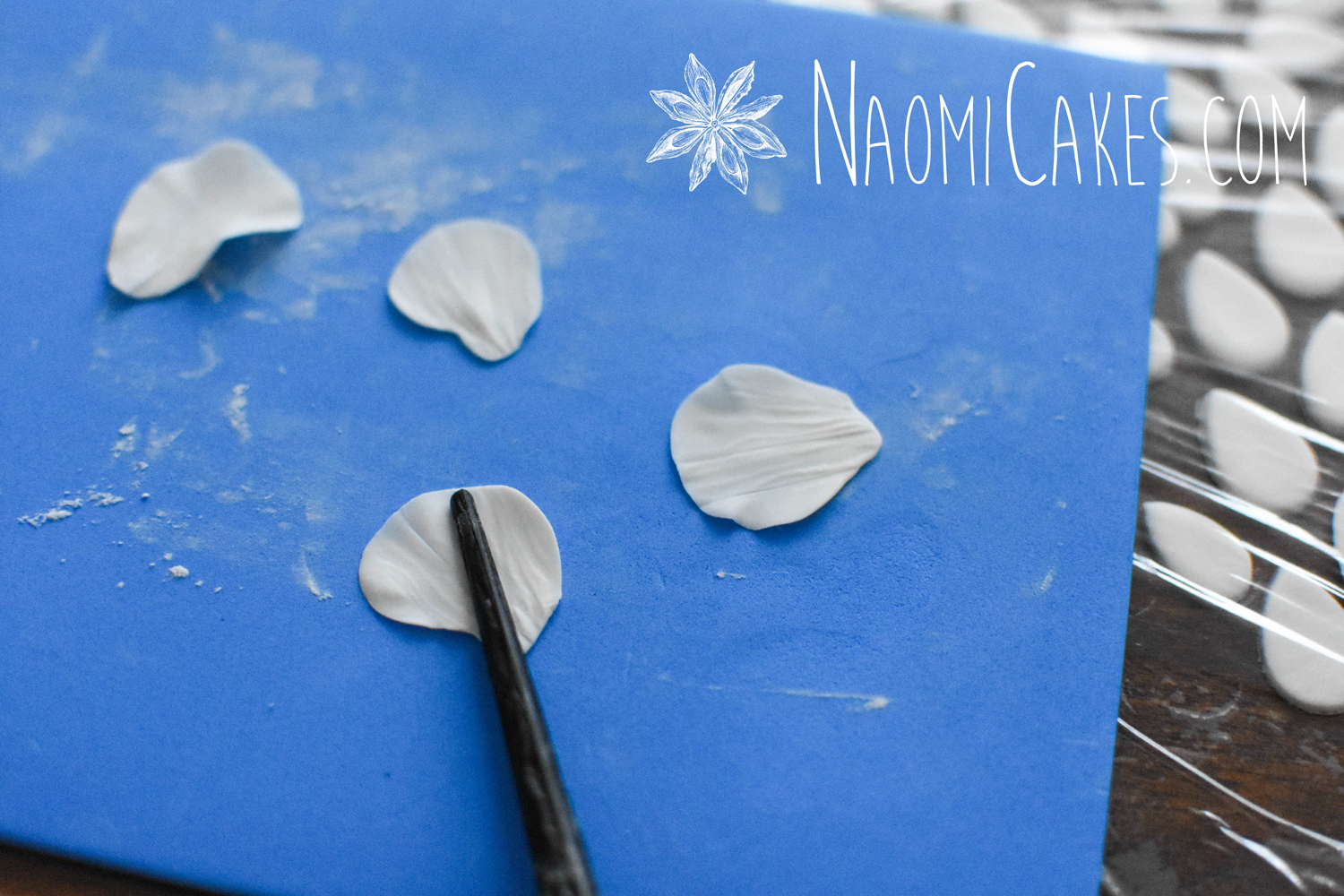
6 – Attaching the petals
Dampen the base (at the pointed end of the petal) of one petal with water (as an edible glue) on the plain side, and wrap it (vein side out) around one rose base, making sure it stands above the top of the base about 1/4″, and the petal overlaps itself slightly (as shown in the photos of this tutorial).
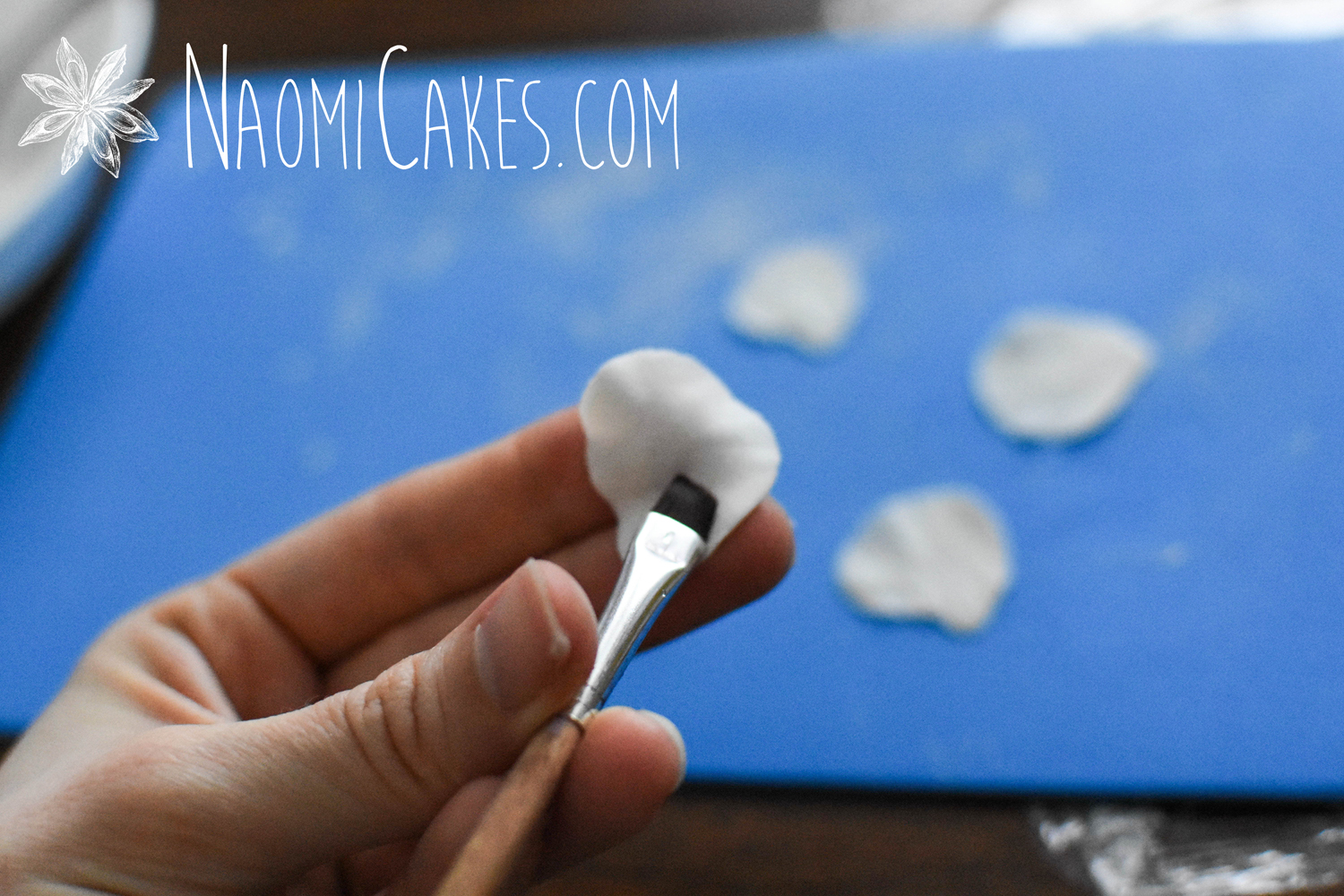
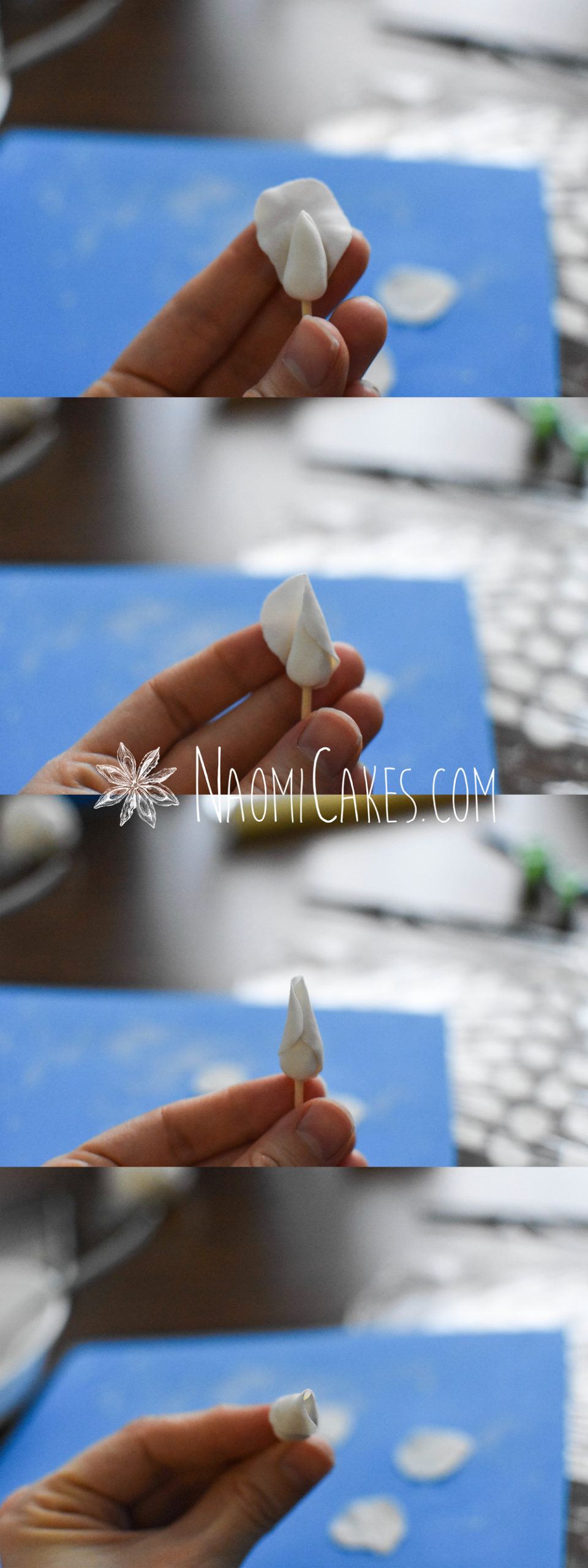
7 & 8 – Completing the rose bud
7 – Moisten the end of another petal on the plain side again, and wrap it around the first petal (vein side out), with the centre of the overlap on the first petal in the middle of the second petal. (See photos in this tutorial to see how to position the top of the petals against each other.)
8 – Repeat with the third petal and then the fourth petal, tucking each underneath the edge of the previous petal to make a spiral “fan.” Use a cell stick to curve the tips of the petals as desired. You have now created the first row of petals for a homemade gum paste rose.
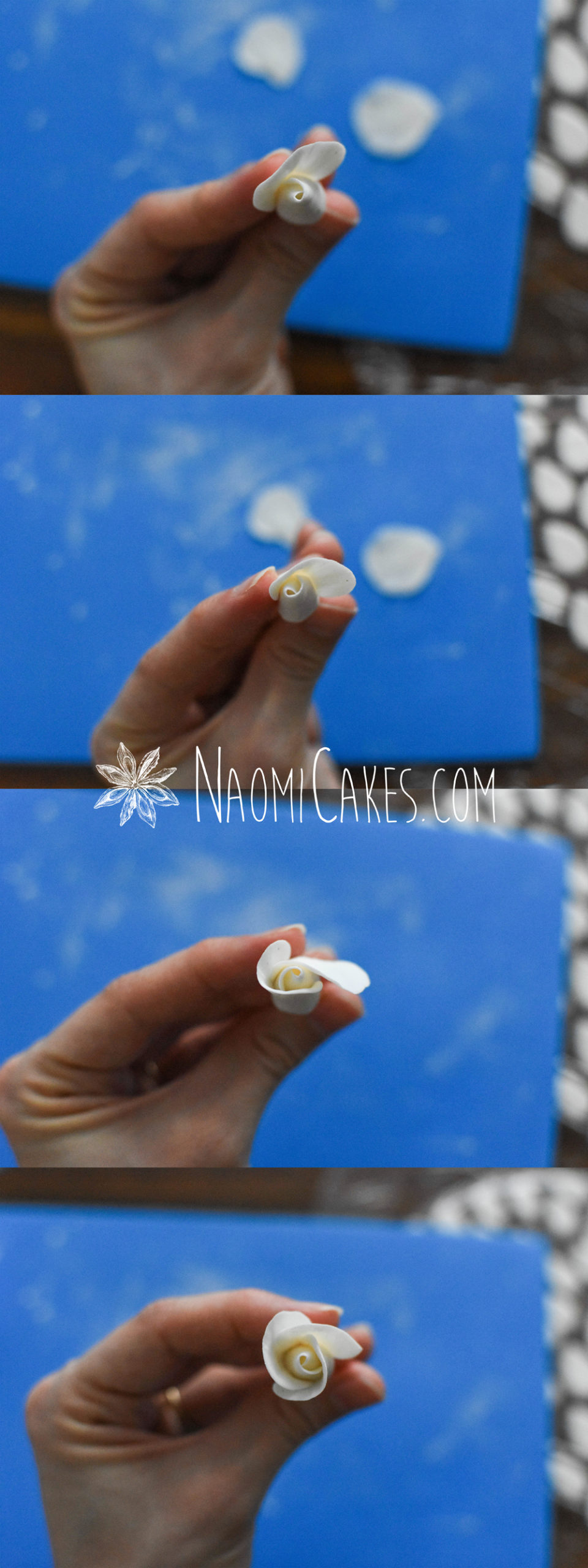
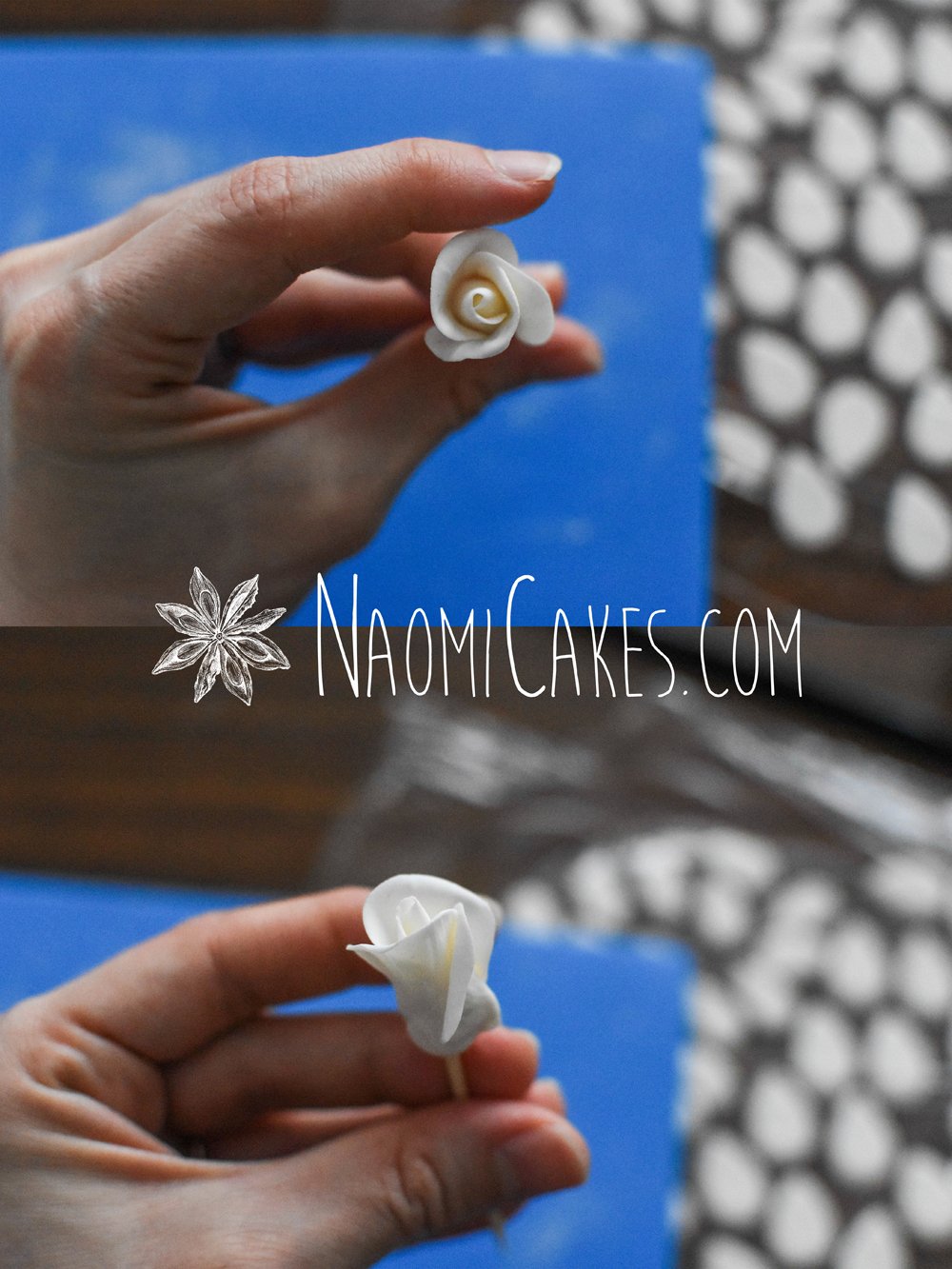
9 & 10 – Drying the rose buds
9 – Stick the toothpick of the finished rose bud into styrofoam; repeat these directions with the other rose bases. Allow the buds to dry at least 12-24 hours before colouring or using them to decorate.
If you are moving on to the next step, you can either let the buds dry or continue on right away.
10 – The thoroughly dry roses will keep in a cool, dry place for several months in a closed container. Humidity will cause the roses to “wilt” and you may not be able to keep them.
If you like this tutorial, you may also like:
- Gum Paste Roses – The Base, Part 1/5 [Tutorial]
- Rustic Wedding Cookies [Tutorial]
- Basic Piping Techniques for Cake Decorating [Tutorial]
- How to Frost a Cake with Buttercream (Smooth Finish) [Tutorial]
There you have it! Done! You’re already becoming a pro.
This part can dry completely before moving on to the next step, or you can continue on to the next step immediately. If you plan to let this piece dry (but you want to add more petals to your rose), I recommend making sure the last petal doesn’t stick out as much I have mine in the picture above; that will make laying new petals on top much easier.
Thanks for following! I’ll be back next week… With the medium sized rose!
–Naomi
This post contains affiliate links.
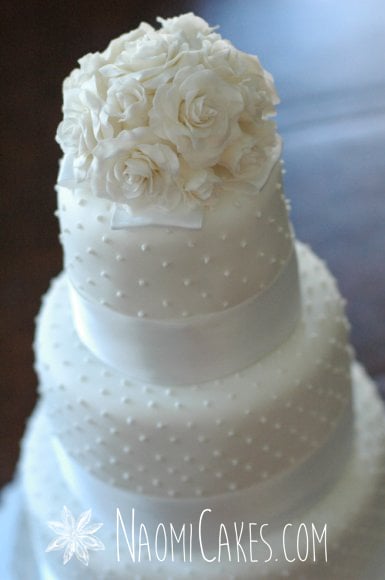
[…] in this section is not making sense visually, the photos in my last two posts, the Rose Base and Rose Bud, will have more visuals for you. Make sure to check those […]